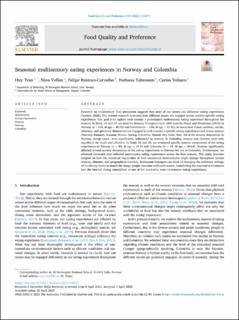Seasonal multisensory eating experiences in Norway and Colombia
Journal article, Peer reviewed
Published version
Permanent lenke
https://hdl.handle.net/11250/3127181Utgivelsesdato
2023Metadata
Vis full innførselSamlinger
Sammendrag
Research on multisensory food perception suggests that most of our senses can influence eating experiences (Spence, 2020). The present research evaluates how different senses are engaged across country-specific eating experiences. Our goal is to explore each country's prototypical multisensory eating experience throughout the seasons. In Study 1A and 1B, we used the Sensory Perception Item (SPI) scale by Haase and Wiedmann (2018) in Norway (n = 104, M age = 40.73) and Colombia (n = 130, M age = 37.81), to assess how visual, auditory, tactile, olfactory, and gustatory dimensions are engaged in each country’s specific eating experiences and across seasons (Norway: Summer, Autumn, Winter, Spring; Colombia: Humid, Dry, Cold, Hot). All of the sensory dimensions in Norway, except touch, were significantly influenced by seasons. In Colombia, seasons and climates were only significant for touch and olfaction. In Study 2A and 2B, we evaluated specific sensory components of the eating experiences in Norway (n = 83, M age = 39.1) and Colombia (n = 64, M age = 40.64). Seasons significantly affected several sensory dimensions of the eating experiences in Norway but not in Colombia. Furthermore, we obtained keywords that reflected participants eating experiences across the four seasons. This study provides insights on how the statistical regularities of food experience environments might change throughout certain seasons, climates, and geographical contexts. Restaurant managers can think of changing the ambience settings of the dining rooms to match the image people associate with each season, transferring the external environment into the internal dining atmosphere as one of the innovative ways to enhance eating experiences.

